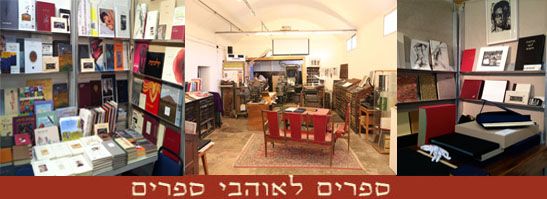עגלת קניות |
||||
|
||||
Even Hoshen |
Even Hoshen Private Press Even Hoshen was founded in 1994 by Uzi Agassi later on was joined by his son Ido. The idea of opening Even Hoshen as a private press came to Uzi after many years as an art curator, and as a book lover - a bibliophile. With his knowledge in typography and book design, Uzi has a special talent for bringing together the work of artists from the world of the visual art with poets and authors to create uniquely aesthetic volumes which bespeak of the highest quality in both form and content. Ido, chose to specialize in the art of bookbinding and letterpress, and thus participate in the creation of books worth looking at as well as reading. Together, in a very special collaboration as father and son, they produce books in limited editions, printed in letterpress, on high quality paper, accompanied by original etching, prints, or woodcuts, with special hand made bindings, elegantly presented in a hand-crafted box. The books are exhibited in libraries, museums, galleries, and private collections around the world. A Letter to Bibliophiles / Uzi Agassi In this way, if we follow it conscientiously and sensitively, we will perhaps be able to arrive at a typeface which will suitable to the requirements of modern printing without departing significantly from the conventional forms. Dr. Moshe Spitzer “On Our Typefaces”, Alei Ayin, “Dreamers of words” (“les rêveurs de mots”): so Gaston Bachelard, in his book from the sixties, La poetique de la rêverie, called all those who love words – the poets, authors, and others who see words as objects that possess form and color. “Dreamers of words” is, it seems to me, a suitable term to describe all bibliophiles the world over, who see books, words and letters as a complex creation, a work of art. It is not insignificant that a fine book is spoken of as a two-dimensional “work of architecture”, and that in Hebrew the title-page of a book is called a “gate”. Especially in the era of computers, miniaturization, video, and the “magnetic book”, when with the aid of the home computer anyone can alter the printed letter beyond recognition – and I am referring not to the blurring and mutilation of basic forms that has occurred in the wake of stylistic and technical developments, but to the ugly distortion which destroys the very function of the printed character – it is necessary to act to restore the dignity of the original Hebrew printed letter and the conception of the book as a work of art. Many fine sayings about the value and importance of books have been recorded in the course of Jewish history, among them the words of Rabbi Moshe Ibn-Ezra (1065-1140) in his essay “The Poetry of Israel”: “Books are sheaths of wisdom embroidered with pearls of rhetoric”, or of Rabbi Itzhak Canfanton (1417-1463): “A man’s wisdom reaches no further than his books reach, and therefore a man should sell all he possesses and buy books…”. In The Book of Hassidim, too, we read: “If a man has gold and books in his hands, and they fall to the ground, he should pick up the books first, and then the gold” (1895). I am also fond of the benediction written by Rabbi Itzhak ben Moshe Halevy (Catalonia, the second half of the 14th century) in the Introduction to his book A Tale of the Ephod, in which he propounds the value of the book’s beauty: “May our study always be in books that are fine and beautiful, with beautiful writing and parchment, and splendid in their accoutrements and coverings… because studying and looking at the fine and open forms and the beautiful drawings will expand the soul, invigorate it, and strengthen its powers. And this has already been agreed on by the physicians…” This is also the goal of Even Hoshen, Publishers of Fine Books. It is our intention to publish books of poetry, short stories, essays of interest in the domains of art in general and the art of printing in particular, as well as single printed sheets – in fact, any subject which is worthy of appearing in an edition for bibliophiles. These will be published in limited and numbered editions, printed in letterpress or intaglio techniques, on high quality paper, and accompanied by original prints. The various series of books will be named after the twelve precious stones of the hoshen, the priest’s breastplate described in the Bible. Even Hoshen will employ two older Hebrew typefaces which are actually an innovation in Hebrew printing practice. One of these is a square 19th-century Ashkenazi font from the famous Drugolin typecasting works in To all the “dreamers” I would like to offer books which are meticulously produced and are works of art both within and without.
|

